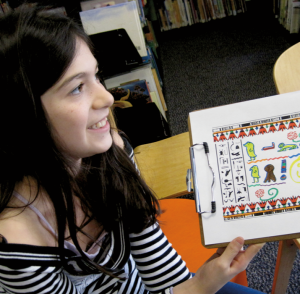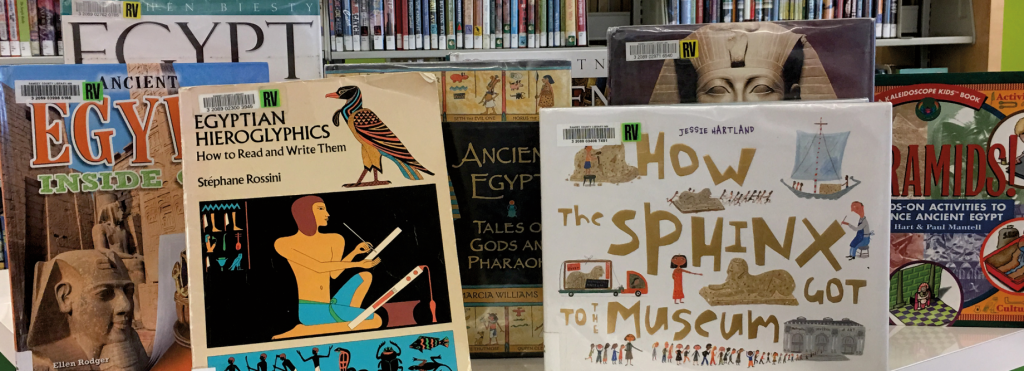8 Hieroglyphs & Secret Codes
Secret code books were among the highest-interest titles in my public and school libraries. There’s something irresistible about being able to write a message that only you and your friends can read. When I was a kid in middle school, a self-proclaimed group of geeks produced an entire newsletter written in Middle Earth Elvish.
Hieroglyphs can give writers the same feeling of mastery, and tie into the Ancient Egypt curriculum familiar to most elementary school students.
The ancient Egyptians created the form of picture-writing known as hieroglyphs around 3100 BCE. (These facts are from the National Endowment for the Humanities Website, z.umn.edu/NEHhieroglyphs.) Each picture was a symbol representing something they observed in their surroundings. A simple drawing of the sun represented the sun, a drawing of a vulture signifies a vulture, a drawing of a rope indicated a rope, and so on. But certain objects, and more particularly ideas, were difficult to represent with a single drawing. Eventually, a system evolved in which a symbol was drawn to represent a specific sound (a consonant). Several symbols were written together to make a word. This is the closest the Egyptians ever came to creating an alphabet. Vowels were not written, but were added (usually eh or ah) by the reader.

Hieroglyphs were written vertically (top to bottom) or horizontally (left to right or right to left). To read a horizontal line, one moved toward the faces of the animal symbols, which all faced in the same direction. There was no punctuation, and to save space two small symbols often occupied the space of one larger one. Although there are thousands of symbols, the most commonly occurring are a set of 24, which modern archaeologists use as a working alphabet.
The one-on-one correspondence of alphabet/phonetic sounds with the Egyptian hieroglyphic symbols creates an opportunity to communicate through writing. Because the project in this workshop is to create a short message and/or sign, it’s a great ice-breaker activity. Writers anxious about “amount of writing” or “filling the page” can communicate without pressure to produce volume.
In our workshops, we find that our writers can also easily create their messages by drawing the glyphs themselves. We give each writer one sheet of paper with the hieroglyphics key and another with an Egyptian-style frame around a space for writing a message.

Mentor texts
Adams, Simon, and Peter Chrisp. 2002. Code Breakers: From Hieroglyphs to Hackers. 1st American ed, Dk Secret Worlds. New York: DK Pub.
Allen, Kathy, and Mari Bolte. 2012. Ancient Egyptian Hieroglyphs. Mankato, Minn.: Capstone Press.
Arlon, Penelope. 2014. Ancient Egypt. Scholastic Discover More. New York, NY: Scholastic Inc.
Blackwood, Gary L., and Jason Henry. 2009. Mysterious Messages: A History of Codes and Ciphers. New York, NY: Dutton Children’s Books.
Chua, Boon Liang. 2008. “Harry Potter and the Coding of Secrets.” Mathematics Teaching in the Middle School 14 (2):114-121.
Colson, Mary. 2011. Destroy after Reading: The World of Secret Codes, Culture in Action. Chicago, Ill.: Raintree.
Deady, Kathleen W. 2012. Ancient Egypt Beyond the Pyramids, Fact Finders Great Civilizations. Mankato, MN: Capstone Press.
Ewert, Marcus, and Lisa Brown. 2015. Mummy Cat. Boston: Clarion Books, Houghton Mifflin Harcourt.
Giblin, James Cross. 1990. The Riddle of the Rosetta Stone : Key to Ancient Egypt, Illustrated with Photographs, Prints, and Drawings. New York: Crowell.
Ham, Catherine. 2017. You Talking to Me? Discover the World of Words, Codes, Emojis, Signs, Slang, Smoke Signals, Barks, Babbles, Growls, Gestures, Hieroglyphics & More. Lake Forest, CA: MoonDance.
Huckle, Helen. 1995. The Secret Code Book. New York: Dial Books.
Iggulden, Conn, and Hal Iggulden. 2007. The Dangerous Book for Boys. New York: Collins.
Janeczko, Paul B., and Jenna LaReau. 2004. Top Secret: A Handbook of Codes, Ciphers, and Secret Writing. Cambridge, MA.: Candlewick Press.
Langley, Andrew. 2010. Codes and Codebreaking, Spies and Spying. Mankato, MN: A+/ Smart Apple Media.
Lee, Stan, and John Buscema. 1978. How to Draw Comics the Marvel Way. New York: Simon and Schuster.
Macaulay, David. 1975. Pyramid. Boston: Houghton Mifflin.
Morawek, Alison. 2011. “Get Cooking with Words! Creating a Recipe Using Procedural Writing.”
Osborne, Mary Pope. 1993. Mummies in the Morning. New York: Random House.
Roehrig, Catharine H., and Metropolitan Museum of Art. 1990. Fun with Hieroglyphs. New York: Metropolitan Museum of Art: Viking.
Rumford, James. 2003. Seeker of Knowledge: The Man Who Deciphered Egyptian Hieroglyphs. New York, NY: Houghton Mifflin Company.
Williams, Marcia. 2011. Ancient Egypt: Tales of Gods and Pharaohs. Somerville, MA: Candlewick Press.
Resources
Chua, Boon Liang. 2008. “Harry Potter and the Coding of Secrets.” Mathematics Teaching in the Middle School 14 (2):114-121.
Discovering Egypt: discoveringegypt.com

